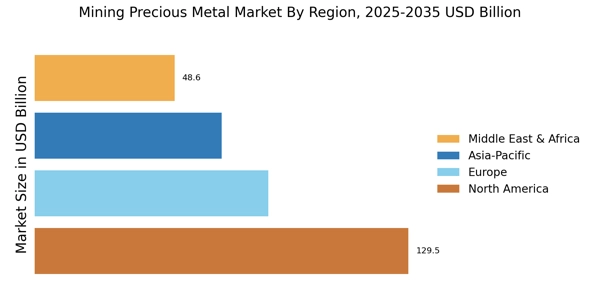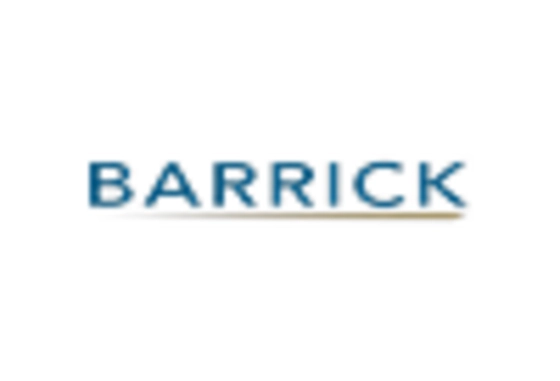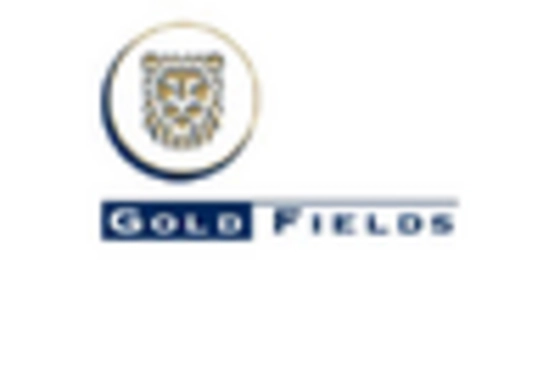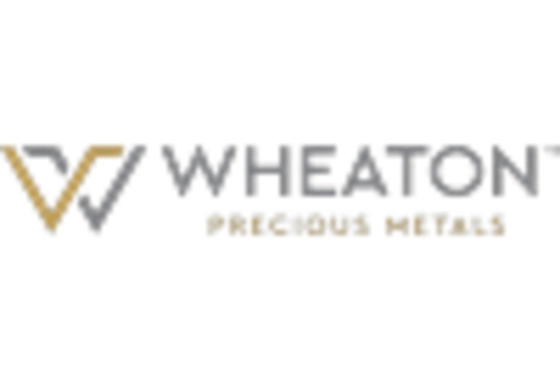Emerging Markets and Urbanization
The Mining Precious Metal Market is witnessing a shift in demand dynamics due to urbanization and the rise of emerging markets. As urban populations grow, the demand for precious metals in construction, electronics, and luxury goods is expected to increase. In 2025, it is projected that emerging markets will account for over 40% of global gold consumption, driven by rising middle-class populations and increased disposable incomes. This trend is likely to encourage mining companies to explore new regions and invest in local operations to meet the burgeoning demand. Additionally, urbanization is leading to greater consumption of precious metals in infrastructure projects, further propelling the Mining Precious Metal Market. As these markets continue to develop, the Mining Precious Metal Market is positioned to benefit from the expanding consumer base and the associated demand for precious metals.
Technological Innovations in Mining
Technological advancements are playing a crucial role in enhancing the efficiency and sustainability of the Mining Precious Metal Market. Innovations such as automated mining equipment, advanced processing techniques, and data analytics are transforming traditional mining practices. For instance, the adoption of autonomous vehicles in mining operations is expected to reduce operational costs by up to 20%, thereby increasing profitability for mining companies. Furthermore, the integration of artificial intelligence in exploration processes is likely to improve the accuracy of resource estimation, leading to more effective mining strategies. As these technologies continue to evolve, the Mining Precious Metal Market is expected to witness increased productivity and reduced environmental impact, making it more attractive to investors and stakeholders alike. This technological shift may also facilitate the transition towards more sustainable mining practices, aligning with global environmental goals.
Increasing Demand for Precious Metals
The Mining Precious Metal Market is experiencing a notable surge in demand for precious metals, driven by various sectors including electronics, automotive, and jewelry. The electronics sector, in particular, has shown a growing appetite for gold and silver due to their excellent conductivity and resistance to corrosion. In 2025, the demand for gold in electronics is projected to reach approximately 300 tons, reflecting a significant increase from previous years. This rising demand is likely to stimulate exploration and production activities within the Mining Precious Metal Market, as companies seek to capitalize on lucrative opportunities. Furthermore, the automotive industry's shift towards electric vehicles is expected to further bolster the demand for precious metals, particularly palladium and platinum, which are essential for catalytic converters. Thus, the Mining Precious Metal Market is poised for growth as it adapts to these evolving market dynamics.
Investment in Precious Metals as a Hedge
In the current economic climate, investors are increasingly turning to precious metals as a hedge against inflation and economic uncertainty. The Mining Precious Metal Market benefits from this trend, as gold and silver are traditionally viewed as safe-haven assets. In 2025, it is estimated that investment demand for gold could account for nearly 30% of total gold demand, reflecting a shift in investor sentiment. This heightened interest in precious metals is likely to drive up prices, encouraging mining companies to expand their operations and invest in new technologies. Additionally, the Mining Precious Metal Market may see an influx of capital as institutional investors seek to diversify their portfolios with precious metals. This trend suggests a robust future for the Mining Precious Metal Market, as it aligns with broader economic conditions and investor behavior.
Regulatory Framework and Environmental Standards
The Mining Precious Metal Market is increasingly influenced by stringent regulatory frameworks and environmental standards. Governments are implementing more rigorous regulations to ensure sustainable mining practices and minimize environmental impact. In 2025, it is anticipated that compliance costs for mining companies could rise by 15% due to these regulations. While this may pose challenges for some operators, it also presents opportunities for those who can innovate and adapt. Companies that prioritize sustainability and adhere to environmental standards are likely to gain a competitive edge in the Mining Precious Metal Market. Moreover, the growing emphasis on corporate social responsibility is prompting mining firms to engage with local communities and invest in social initiatives, further enhancing their reputation and operational viability. Thus, navigating the regulatory landscape effectively is essential for success in the Mining Precious Metal Market.


















Leave a Comment